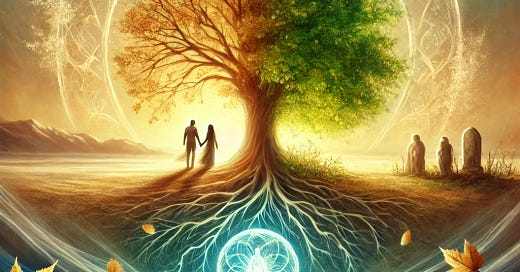Reminiscent of the classic movie entitled Four Weddings and a Funeral, Parshat Chayei Sarah presents us with three weddings and four funerals. The parsha opens with Sarah’s passing, followed by Abraham’s challenging quest to secure a burial site for her—Maarat HaMachpela (the Cave of Machpelah)—a site that becomes a permanent legacy for the Jewish people. The midrash adds another layer by suggesting that Abraham had just finished burying his father, Terach, before he buried Sarah. The parsha later recounts Abraham’s death, with his burial conducted by his sons, Isaac and Ishmael, and concludes with Ishmael’s burial, marking the end of his story.
Juxtaposed with these funerals are three significant weddings. Isaac marries Rebecca, Abraham remarries Keturah (identified by some as Hagar), and Abraham and Sarah’s relationship is celebrated through Eshet Chayil, a eulogy composed by Abraham in Sarah’s honor. These events signify the cycle of life, where endings give way to new beginnings.
A hidden connection between marriage and burial is embedded in the name of Rebecca (רִבְקָה), the bride central to this story. When rearranged, the letters of Rivka (רִבְקָה) spell Kevurah (קְבוּרָה, burial). The Gemara in Mesechet Kiddushin 2a highlights this link between marriage and burial, through the phrase "kicha kicha misedei Ephron, “קיחָה קיחָה מִשְּׂדֵה עֶפְרוֹן" which describes Abraham’s purchase of the Cave of Machpelah and also becomes the foundation for the legal framework of Jewish marriage. This phrase describes how acquisition through something of monetary value—like a ring—establishes the marital bond, a practice still used in Jewish weddings today.
Another layer of meaning is revealed through an unexpected detail: the prominence of camels in Chayei Sarah. The Parsha contains more references to camels than the rest of the Torah combined. Eliezer, Abraham’s servant, embarks on his mission to find a wife for Isaac with camels, and Rebecca’s extraordinary kindness is demonstrated when she waters them—a task requiring immense effort given their thirst. Later, the Torah humorously notes Rebecca falling off a camel upon meeting Isaac. Why the focus on camels?
Camels have a special symbolism. Their ability to sustain themselves for long periods without water reflects resilience and self-reliance. This symbolism deepens when we consider Isaac’s weaning, described by the term vayigmal, meaning, quite literally, “he became a camel.” The highest form of Jewish kindness, gemilut chasadim—literally, “camel kindness”—draws on this idea as well, that the ultimate form of giving is empowering others to become self-sufficient. This principle is echoed in the Rambam’s teaching that the highest level of charity is providing someone with a livelihood, fostering their independence much like the camel.
Jewish marriage also reflects this ideal. The Torah teaches
עַל־כֵּן יַעֲזָב־אִישׁ אֶת־אָבִיו וְאֶת־אִמּוֹ וְדָבַק בְּאִשְׁתּוֹ וְהָיוּ לְבָשָׂר אֶחָד
“a man shall leave his parents [home] and cling to his wife [Genesis 2:24.]
emphasizing independence as a foundation for partnership. Marriage, in its ideal form, is not about neediness or dependency, or about losing one’s self in a union, but about two independent individuals freely choosing to give one another love and support.
Abraham’s journey exemplifies this growth. At various points in last week's Parsha, he refers to Sarah as his sister, a dynamic that reflects a lack of clarity in their relationship. This portrayal, akin to a sibling bond, contrasts with the Torah’s ideal of a marital partnership rooted in independence. Only after Sarah’s death does Abraham fully embrace his independence. He remarries, secures Isaac’s future, and ensures his family’s continuity. This is why our parsha is ironically titled Chayei Sarah—the life of Sarah—even though it recounts her death. Abraham’s transformation teaches us that loss can inspire renewal and that independence is not a barrier to connection but its foundation.
This profound truth resonates deeply, especially during challenging times. On Thursday night, I attended the Magen David Adom dinner, where story after story highlighted the heroism of paramedics during and after the October 7 attacks. Their courage in saving lives was inspiring, but what stood out even more was the collective attitude: not despair, but resolute determination to move forward toward better days.
On October 7, Israel faced unimaginable tragedy—death, destruction, and heartbreak. Yet, like Abraham after Sarah’s passing, the Jewish people refused to be overcome. Instead, they chose resilience and life, responding with unity and hope.
The lessons of Chayei Sarah teach us to find renewal amid loss. Like Abraham, Rebecca, and the Jewish people today, may we always choose life, building a future filled with hope and purpose.
Shabbat Shalom,
Rabbi Eliezer Hirsch


